Training your biceps is a key part of growing and sculpting your arms. Whether you are a gym rat or forming your first training plan, the exercises below will help you meet your fitness goals.
dumbbell zottman preacher curl
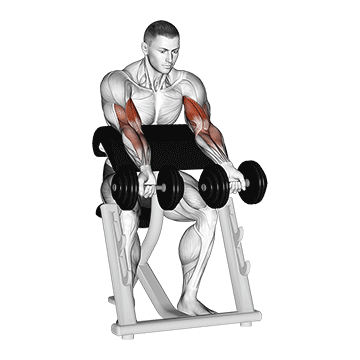
1. Start by selecting a pair of dumbbells of appropriate weight. Remember, it's better to start light and increase weight as you get comfortable with the exercise.
2. Position yourself on a preacher bench, ensuring your chest and stomach are firmly pressed against the pad. Your feet should be flat on the floor.
3. Grab the dumbbells with an underhand grip (palms facing up) and extend your arms fully. This is your starting position.
4. Slowly curl the dumbbells up towards your shoulders while keeping your upper arms and elbows stationary on the pad. Ensure you are only moving your forearms.
5. Once the dumbbells reach shoulder level, pause for a moment and then rotate your wrists so that your palms are now facing downwards.
6. Slowly lower the dumbbells back to the starting position while maintaining this overhand grip.
7. Once your arms are fully extended, rotate your wrists back to the underhand grip. This completes one repetition.
8. Repeat the exercise for your desired number of repetitions.
Remember to keep your movements controlled and steady, focusing on the muscle contraction and not on the weights you are lifting. Avoid using your back or shoulders to lift the weights; your biceps should do all the work.
dumbbell zottman curl
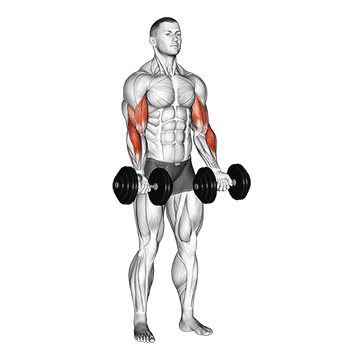
To perform the Dumbbell Zottman Curl, follow these steps:
1. Stand up straight with a dumbbell in each hand, arms fully extended, and palms facing your torso. This will be your starting position.
2. While keeping your upper arms stationary, curl the weights while contracting your biceps as you breathe out. Only the forearms should move. Continue the movement until your biceps are fully contracted and the dumbbells are at shoulder level. Hold the contracted position for a brief moment as you squeeze your biceps.
3. Now, instead of bringing the dumbbells back down using the same path, rotate your wrists so that the palms of your hands are facing down (pronated grip).
4. Slowly begin to bring the dumbbells back down using the pronated grip. Keep your upper arms stationary and only move your forearms.
5. When the dumbbells reach your thighs, start rotating the wrist so that you go back to a neutral (palms facing your torso) grip.
6. Repeat for the recommended amount of repetitions.
Remember to keep your elbows close to your torso at all times and avoid using your back or shoulders to lift the weights; your forearms should do all the work. Also, ensure that your movement is slow and controlled, avoid any fast or jerky movements.
dumbbell waiter biceps curl
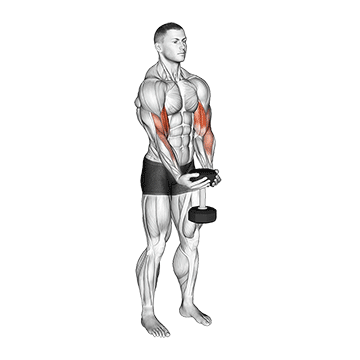
To perform the dumbbell waiter biceps curl, start by standing tall with your feet hip-width apart. Hold a dumbbell in one hand with your palm facing upward, as if you're a waiter holding a tray.
Keep your elbow close to your body and your upper arm stationary. This is your starting position.
Now, exhale and curl the dumbbell towards your shoulder while keeping your forearm horizontal to the floor, similar to a waiter carrying a tray. Ensure that only your forearm is moving and your upper arm remains stationary.
Hold this position for a second as you squeeze your biceps at the top of the movement.
Inhale and slowly lower the dumbbell back to the starting position.
Repeat this movement for the desired number of repetitions and then switch to the other arm.
Remember to keep your core engaged and back straight throughout the exercise to maintain proper form and prevent injury.
dumbbell step up single leg balance with bicep curl
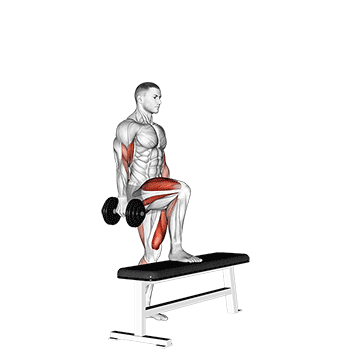
1. Start by selecting a pair of dumbbells that you're comfortable with. Ensure the weight is challenging but not too heavy that it compromises your form.
2. Stand upright, facing a sturdy bench or step. Hold the dumbbells at your sides with your palms facing forward.
3. Step up onto the bench with your right foot, pressing through your heel to lift your body upward. As you step up, balance on your right leg and bring your left knee up to hip height.
4. While balancing on your right leg, perform a bicep curl by bending your elbows and bringing the dumbbells up towards your shoulders. Keep your elbows close to your body and ensure your upper arms are stationary.
5. Lower the dumbbells back down to your sides while maintaining your balance on the right leg.
6. Slowly lower your left foot back to the ground, followed by your right foot to return to the starting position.
7. Repeat the exercise, this time stepping up with your left foot and balancing on your left leg.
8. Continue to alternate legs for the desired number of reps or time duration.
Remember to keep your core engaged throughout the exercise to help maintain balance. Also, ensure your back is straight and your gaze is forward to avoid straining your neck.
dumbbell standing zottman preacher curl
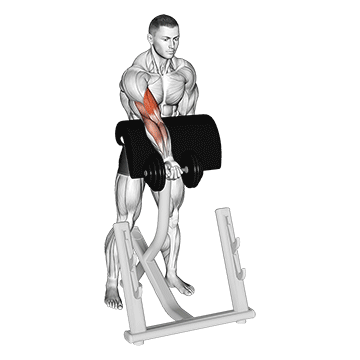
1. Stand upright with your feet shoulder-width apart. Hold a dumbbell in each hand with your palms facing forward. This is your starting position.
2. Curl the weights while contracting your biceps as you breathe out. Keep the upper arms stationary and continue the curl until your biceps are fully contracted and the dumbbells are at shoulder level.
3. Hold the contracted position for a second as you squeeze your biceps.
4. Now, rotate your wrists until your palms are facing downward. This is the Zottman position.
5. Slowly begin to bring the dumbbells back down using the same path. Continue lowering the weight until your biceps are fully extended and your arms are fully stretched.
6. Rotate your wrists back to the starting position once the arms are fully extended at the bottom.
7. Repeat for the recommended amount of repetitions.
Remember to keep your elbows close to your torso at all times and do not use your back or shoulders to lift the weights; your biceps should do all the work. Ensure your movements are slow and controlled to maximize muscle engagement.
dumbbell standing reverse curl
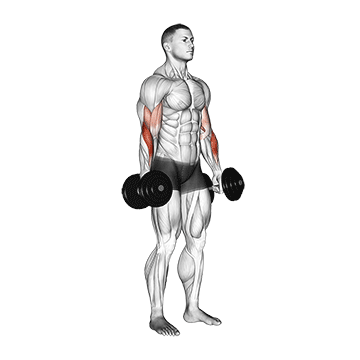
1. Stand up straight with a dumbbell in each hand, arms fully extended, and palms facing your torso. This will be your starting position.
2. While keeping your upper arms stationary, exhale and curl the weights while contracting your biceps. Continue to raise the weights until your biceps are fully contracted and the dumbbells are at shoulder level. Hold the contracted position for a brief moment as you squeeze your biceps.
3. Inhale and slowly begin to lower the dumbbells back to the starting position.
4. Repeat this movement for the recommended amount of repetitions.
Remember to keep your elbows close to your torso at all times and do not use your back or shoulders to lift the weights; your biceps should do all the work.
dumbbell standing preacher curl
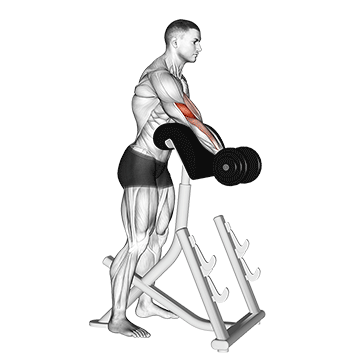
1. Stand upright and hold a dumbbell in one hand. Your feet should be shoulder-width apart for balance.
2. Extend your arm fully and place the back of the upper arm against your inner thigh. This is your starting position.
3. Slowly curl the dumbbell up while keeping the upper arm stationary. Continue to raise the dumbbell until your biceps are fully contracted and the dumbbell is at shoulder level. Hold the contracted position for a brief moment as you squeeze your biceps.
4. Gradually lower the dumbbell back to the starting position in a controlled manner. Ensure that your arm is fully extended and the bicep is fully stretched.
5. Repeat the movement for the recommended amount of repetitions.
6. Switch arms and perform the same steps.
Remember to keep your body stationary throughout the exercise. The only part that should move is your forearm. This will ensure that your biceps are fully engaged and you get the most out of the exercise.
dumbbell standing one arm reverse curl
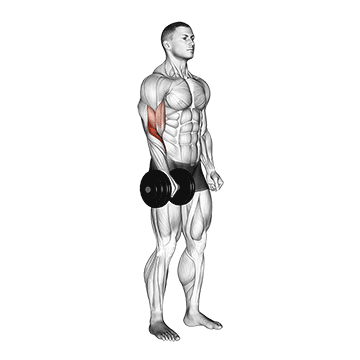
1. Stand upright with your feet shoulder-width apart. Hold a dumbbell in one hand with your palm facing towards your body. This is your starting position.
2. Keep your elbow close to your torso at all times. Your other hand can be kept on your hip or hanging by your side for balance.
3. Slowly curl the dumbbell upwards while keeping your palm facing down. Continue to lift the dumbbell until your biceps are fully contracted and the dumbbell is at shoulder level. Hold the contracted position for a brief moment as you squeeze your biceps.
4. Gradually lower the dumbbell back to the starting position in a controlled manner. Ensure that your arm is fully extended and your biceps are fully stretched.
5. Repeat the movement for the recommended amount of repetitions.
6. Once you have completed the set, switch arms and repeat the exercise.
Remember to keep your upper body still throughout the exercise. The only part of your body that should be moving is your arm. Also, ensure that you are using a weight that is challenging but allows you to maintain proper form.
dumbbell standing one arm curl over incline bench
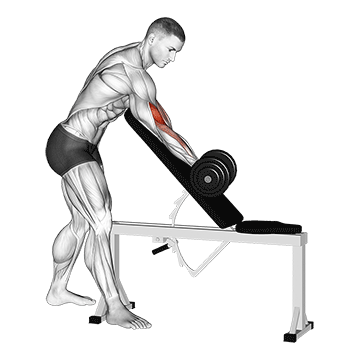
1. Start by selecting a dumbbell of appropriate weight. Remember, it's better to start light and increase weight as needed to maintain proper form.
2. Position yourself next to an incline bench, standing up straight with your feet shoulder-width apart.
3. Hold the dumbbell in one hand, letting it hang at arm's length. Your palm should be facing forward, and the back of your arm should be resting against the incline bench for support.
4. Keep your upper arm stationary, exhale and curl the weight while contracting your biceps. Continue to raise the weight until your biceps are fully contracted and the dumbbell is at shoulder level. Hold the contracted position for a brief moment as you squeeze your biceps.
5. Inhale and slowly begin to lower the dumbbell back to the starting position.
6. Repeat for the recommended amount of repetitions. Then switch arms and repeat the exercise.
7. Ensure your upper arm is always stationary, your elbow is close to your torso, and only your forearm should move during the exercise to ensure maximum bicep engagement.
8. Avoid using your back or shoulders to lift the weights; your biceps should do all the work.
9. Repeat this exercise for the desired number of sets.
dumbbell standing one arm curl (over incline bench)
_Upper-Arms_360.gif)
1. Start by selecting a dumbbell of appropriate weight. Remember, it's better to start light and increase weight as needed to maintain proper form.
2. Stand next to an incline bench, with your feet shoulder-width apart for stability.
3. Hold the dumbbell in your right hand with your palm facing forward. Your arm should be fully extended and hanging down at your side. This is your starting position.
4. Slowly bend your elbow to lift the dumbbell towards your shoulder. Keep your upper arm stationary and only move your forearm. Ensure your elbow stays close to your body throughout the movement.
5. Pause for a moment when the dumbbell is at shoulder level, squeezing your bicep muscle at the top of the curl.
6. Slowly lower the dumbbell back to the starting position, fully extending your arm and stretching your bicep muscle.
7. Repeat the movement for your desired number of repetitions.
8. Once you've completed your set, switch the dumbbell to your left hand and repeat the exercise.
9. Remember to keep your back straight and your core engaged throughout the exercise to prevent injury and maximize effectiveness.
10. For best results, perform this exercise in 2-3 sets of 8-12 repetitions on each arm.
dumbbell standing one arm concentration curl
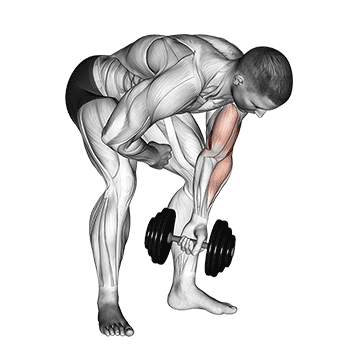
1. Stand upright with your feet shoulder-width apart. Hold a dumbbell in one hand, letting it hang at arm's length. Your palm should be facing forward.
2. Place your free hand on your hip for balance. This will be your starting position.
3. Slowly bend your elbow and curl the dumbbell as close to your shoulder as you can. Keep your upper arm stationary, only your forearm should move.
4. Hold this position for a second to maximize the peak contraction in the biceps.
5. Gradually lower the dumbbell back to the starting position in a controlled manner.
6. Repeat the movement for the desired number of repetitions.
7. Once you've completed your set, switch the dumbbell to your other hand and repeat the exercise.
Remember to keep your back straight and your movements smooth throughout the exercise. Avoid using your back or shoulders to lift the weight; your biceps should do all the work.
dumbbell standing inner biceps curl v. 2
1. Stand up straight with a dumbbell in each hand, arms fully extended, and palms facing your torso. This will be your starting position.
2. While holding the upper arm stationary, curl the weights while contracting the biceps as you breathe out. Only the forearms should move. Continue the movement until your biceps are fully contracted and the dumbbells are at shoulder level. Hold the contracted position for a brief moment as you squeeze your biceps.
3. Now, slowly begin to bring the dumbbells back to the starting position as your breathe in.
4. Repeat this movement for the recommended amount of repetitions.
Remember to keep your elbows close to your torso at all times and do not use your back or shoulders to lift the weights; your biceps should do all the work.
dumbbell standing concentration curl
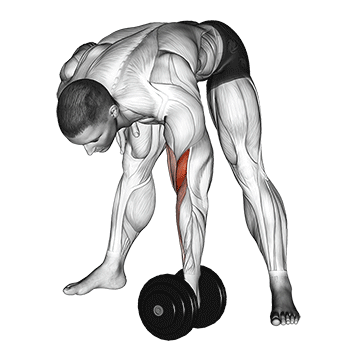
1. Stand up straight with a dumbbell in your hand, feet shoulder-width apart. Ensure your palms are facing forward and the dumbbell is at arm's length. This will be your starting position.
2. While keeping your upper arm stationary, curl the weights while contracting your biceps as you breathe out. Only the forearms should move. Continue the movement until your biceps are fully contracted and the dumbbells are at shoulder level. Hold the contracted position for a brief pause as you squeeze your biceps.
3. Slowly begin to bring the dumbbells back to the starting position as your breathe in.
4. Repeat the process for the recommended amount of repetitions. Switch arms after completing the set.
Remember to keep your elbows close to your torso at all times and do not use your back or shoulders to lift the weights; your biceps should do all the work. Ensure your movements are slow and controlled, don't let the dumbbell's weight pull your arm down in a rapid movement.
dumbbell standing biceps curl
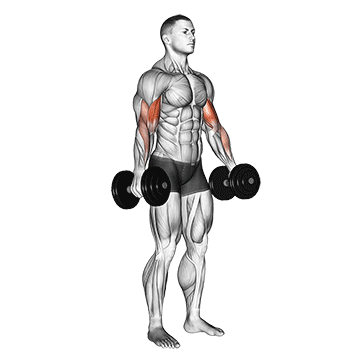
1. Stand up straight with a dumbbell in each hand, arms fully extended, and palms facing forward. Your feet should be shoulder-width apart. This is your starting position.
2. Keep your upper arms stationary, exhale and curl the weights while contracting your biceps. Continue to raise the weights until your biceps are fully contracted and the dumbbells are at shoulder level. Hold the contracted position for a brief pause as you squeeze your biceps.
3. Inhale and slowly begin to lower the dumbbells back to the starting position.
4. Repeat this movement for the desired number of repetitions.
Remember to keep your elbows close to your torso at all times and do not use your back or shoulders to lift the weights; your biceps should do all the work. Also, ensure your movements are slow and controlled - don't use momentum to lift the weights.
dumbbell standing alternate hammer curl and press
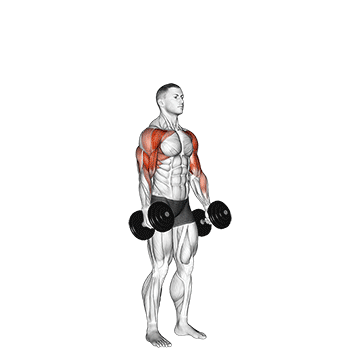
1. Stand upright with your feet shoulder-width apart. Hold a dumbbell in each hand with your palms facing your torso. This is your starting position.
2. Keep your upper arms stationary, exhale and curl the weights while contracting your biceps. Continue to raise the weights until your biceps are fully contracted and the dumbbells are at shoulder level. Hold the contracted position for a brief moment as you squeeze your biceps.
3. Now, rotate your palms until they are facing forward. Press the dumbbells up until your arms are fully extended above your head. Exhale as you perform this step.
4. Lower the dumbbells back down to the shoulder level while inhaling.
5. Rotate your palms to the starting position and lower the dumbbells back down to the original position while exhaling.
6. Repeat the movement for the prescribed amount of repetitions.
Remember to keep your elbows close to your torso at all times and do not use your back or shoulders to lift the weights; your biceps should do all the work. Ensure your movements are slow and controlled, don't let the momentum of the weights do the work.
dumbbell seated revers grip concentration curl
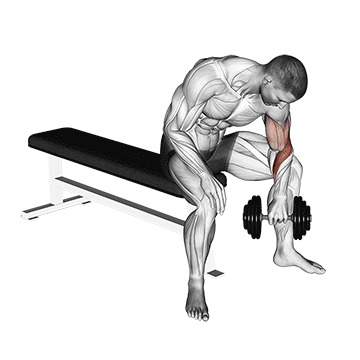
1. Start by sitting on the edge of a flat bench with your feet firmly planted on the ground.
2. Grab a dumbbell with your right hand using a reverse grip (palm facing down).
3. Spread your legs apart and lean forward slightly. Rest your right elbow on the inside of your right thigh, just above the knee. Your arm should be fully extended and the dumbbell should be just off the floor.
4. Keep your back straight and your upper body still throughout the exercise. The only part of your body that should move is your arm.
5. Curl the dumbbell up towards your chest, keeping your palm facing down. Make sure to keep your elbow stationary and only move your forearm.
6. Pause for a moment at the top of the curl, squeezing your bicep.
7. Slowly lower the dumbbell back down to the starting position, fully extending your arm.
8. Repeat the movement for your desired number of repetitions.
9. Once you've completed your set, switch the dumbbell to your left hand and repeat the exercise.
Remember to keep your movements slow and controlled, focusing on the muscle contraction and not on the weights you are lifting. This exercise is not about lifting heavy, but rather about targeting and isolating the biceps.
dumbbell seated preacher curl
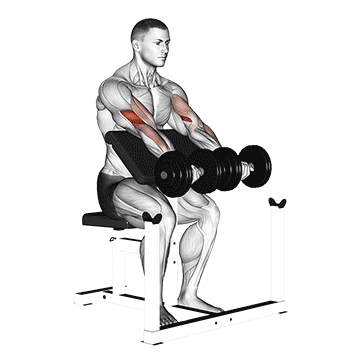
1. Start by sitting on a preacher bench and adjust the height so that your armpits rest comfortably at the top of the pad.
2. Hold a dumbbell in one hand using an underhand grip (palm facing upwards).
3. Place the back of your upper arm and elbow on the preacher pad. Your arm should be fully extended and your palm should be facing upward.
4. Keep your arm and shoulder stationary, curl the dumbbell upwards towards your shoulder while contracting your biceps. Ensure to keep your wrist straight throughout the movement.
5. Pause at the top of the movement for a second and squeeze your biceps.
6. Slowly lower the dumbbell back to the starting position, fully extending your arm and stretching your biceps.
7. Repeat the movement for the desired number of repetitions.
8. Switch arms and repeat the exercise.
Remember to maintain a controlled movement throughout the exercise, avoiding any swinging or momentum use.
dumbbell seated one arm bicep curl on exercise ball with leg raised
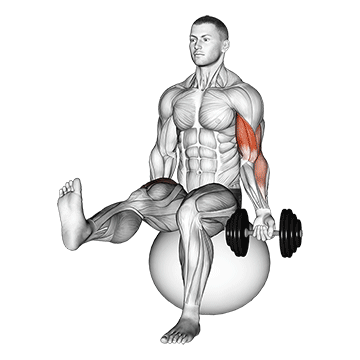
1. Start by sitting upright on an exercise ball with your feet flat on the floor. Make sure your back is straight and your core is engaged.
2. Hold a dumbbell in one hand with your palm facing forward. The other hand can rest on your hip or the exercise ball for balance.
3. Lift one foot off the ground, keeping your leg straight. This will engage your core and provide an additional challenge to the exercise.
4. Slowly curl the dumbbell up towards your shoulder, keeping your elbow close to your body. Ensure that only your forearm is moving and your upper arm remains stationary.
5. Pause at the top of the curl for a moment, squeezing your bicep muscle.
6. Slowly lower the dumbbell back down to the starting position. This should take about twice as long as it did to lift it.
7. Repeat this movement for your desired number of repetitions. Then switch to the other arm and leg and repeat the same number of repetitions.
8. For a complete workout, aim for 2-3 sets on each side. Remember to keep your movements slow and controlled, focusing on the muscle contraction and not on the weights you are lifting.
dumbbell seated neutral wrist curl
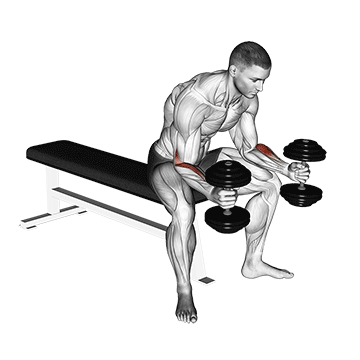
1. Start by sitting on a flat bench with your feet firmly planted on the ground.
2. Hold a dumbbell in each hand with your palms facing each other (neutral grip).
3. Rest your elbows on your thighs, allowing your wrists to hang over the edge of your knees.
4. Slowly lower the dumbbells towards the ground by only moving your wrists.
5. Once your wrists are fully extended, pause for a moment.
6. Curl the dumbbells back up towards your biceps by flexing your wrists.
7. Squeeze your biceps at the top of the movement and hold for a second.
8. Repeat this movement for your desired number of repetitions.
Remember to keep your arms stationary throughout the exercise, the movement should only be happening at your wrists. Also, ensure to use a weight that is challenging but allows you to maintain proper form.
dumbbell seated inner biceps curl
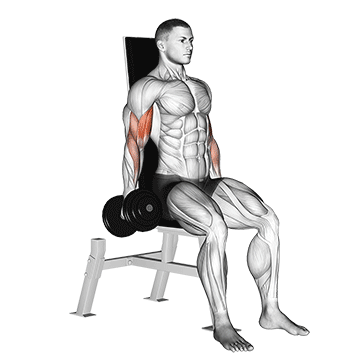
Begin by sitting on a flat bench with a dumbbell in each hand. Your feet should be flat on the floor, about shoulder-width apart.
Hold the dumbbells with your palms facing each other, arms fully extended, and close to your body. This is your starting position.
Slowly curl the weights while keeping your palms facing each other. Continue to raise the weights until your biceps are fully contracted and the dumbbells are at shoulder level. Hold the contracted position for a brief moment as you squeeze your biceps.
Slowly begin to lower the dumbbells back to the starting position. Make sure to keep your movements controlled, resisting the weight as you lower it.
Repeat this movement for the desired number of repetitions. Remember to keep your back straight and your movements controlled throughout the exercise.
Avoid using your back or shoulders to lift the weights; your biceps should do all the work. This exercise can also be performed one arm at a time.
dumbbell seated hammer curl
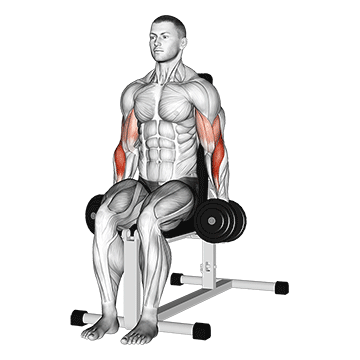
1. Start by sitting down on a flat bench with a dumbbell in each hand. Your feet should be flat on the floor, about shoulder-width apart.
2. Hold the dumbbells with your palms facing your torso, this is your starting position. This grip is known as a hammer grip.
3. Keep your upper arms stationary, exhale and curl the weights while contracting your biceps. Continue to raise the weights until your biceps are fully contracted and the dumbbells are at shoulder level. Hold the contracted position for a brief moment as you squeeze your biceps.
4. Inhale and slowly begin to lower the dumbbells back to the starting position.
5. Repeat this movement for the desired number of repetitions.
Remember to keep your elbows close to your torso at all times and do not use your back or shoulders to lift the weights; your forearms should do all the work. Your upper arms should remain stationary throughout the exercise.
dumbbell seated curl
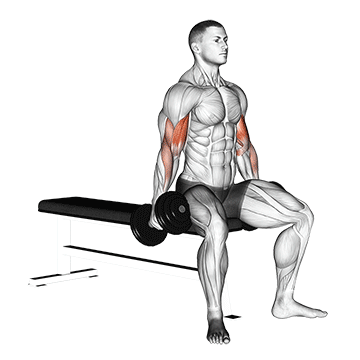
1. Start by sitting on a flat bench with your feet firmly planted on the ground. Your back should be straight and your shoulders relaxed.
2. Hold a dumbbell in each hand with your palms facing forward. The dumbbells should be at arm's length and your elbows should be close to your torso. This is your starting position.
3. Slowly curl the weights while keeping your upper arms stationary. Continue to raise the weights until your biceps are fully contracted and the dumbbells are at shoulder level. Hold the contracted position for a brief pause as you squeeze your biceps.
4. Gradually begin to lower the dumbbells back to the starting position in a controlled manner. Do not let gravity do the work; ensure your biceps are fully engaged.
5. Repeat this movement for the desired number of repetitions. Remember to keep your breathing steady throughout the exercise - inhale as you lower the weights and exhale as you curl them up.
6. Ensure your movements are slow and controlled, focusing on the muscle contraction and not on the weights you are lifting. Avoid using your back or shoulders to lift the weights; your biceps should do all the work.
7. For best results, perform this exercise for 3-4 sets of 10-15 repetitions.
dumbbell seated biceps curl to shoulder press
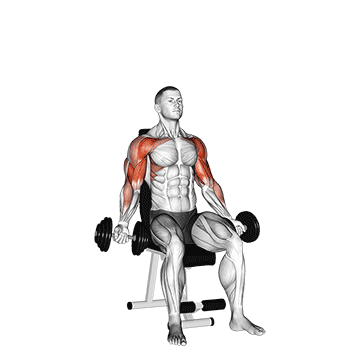
1. Start by sitting on a flat bench with a dumbbell in each hand. Your feet should be flat on the floor, about shoulder-width apart.
2. Hold the dumbbells at arm's length by your sides, with your palms facing forward. This is your starting position.
3. Bend your elbows and curl the dumbbells as close to your shoulders as you can. Keep your elbows close to your torso at all times.
4. Hold this position for a second, squeezing your biceps at the top of the curl.
5. Now, rotate your palms so they are facing forward and press the dumbbells up over your head until your arms are fully extended.
6. Pause for a moment at the top, then slowly lower the dumbbells back down to the starting position.
7. Repeat this movement for your desired number of repetitions.
Remember to keep your back straight and your core engaged throughout the exercise to protect your spine. Also, ensure that you are lifting a weight that is challenging but allows you to maintain proper form.
dumbbell seated biceps curl (on stability ball)
_Upper-Arms_360.gif)
Begin by sitting on a stability ball with your feet flat on the floor, shoulder-width apart. Hold a dumbbell in each hand with your arms fully extended and palms facing forward.
Engage your core and maintain a straight back. This is your starting position.
Slowly bend your elbows to lift the dumbbells towards your shoulders. Keep your upper arms stationary and only move your forearms. Ensure your elbows stay close to your body to maximize bicep engagement.
Pause at the top of the curl, squeezing your biceps.
Slowly lower the dumbbells back to the starting position, maintaining control of the movement.
Repeat this process for your desired number of repetitions. Remember to breathe in as you lower the weights and breathe out as you lift them.
Ensure you maintain good posture throughout the exercise, keeping your back straight and your core engaged. The stability ball will help to engage your core and improve your balance as you perform the curls.
dumbbell seated bicep curl
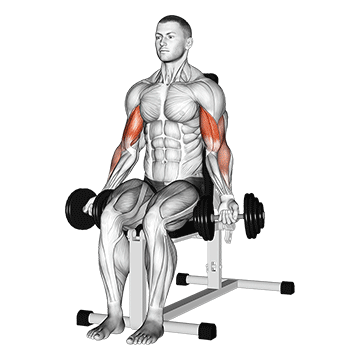
1. Start by sitting on a flat bench with a dumbbell in each hand at arm's length. Keep your elbows close to your torso and rotate the palms of your hands until they are facing forward. This will be your starting position.
2. Now, keeping the upper arms stationary, exhale and curl the weights while contracting your biceps. Continue to raise the weights until your biceps are fully contracted and the dumbbells are at shoulder level. Hold the contracted position for a brief moment as you squeeze your biceps.
3. Then inhale and slowly begin to lower the dumbbells back to the starting position.
4. Repeat this movement for the recommended amount of repetitions.
Remember to keep your elbows close to your torso at all times and do not use your back or shoulders to lift the weights; your biceps should do all the work. Also, ensure your upper arms remain stationary throughout the exercise.
dumbbell seated alternate hammer curl on exercise ball
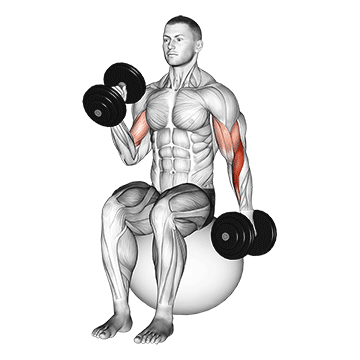
1. Start by sitting upright on an exercise ball with your feet flat on the floor. Your knees should be bent at a 90-degree angle and your back should be straight.
2. Hold a dumbbell in each hand with your palms facing your torso. This is your starting position.
3. Keep your upper arms stationary, exhale and curl the weight while contracting your biceps. Continue to raise the weight until your biceps are fully contracted and the dumbbells are at shoulder level. Hold the contracted position for a brief moment as you squeeze your biceps.
4. Inhale and slowly begin to lower the dumbbells back to the starting position.
5. Repeat the movement with the opposite arm. This is one rep.
6. Continue alternating arms for the desired number of repetitions.
Remember to keep your elbows close to your torso at all times and do not use your back or shoulders to lift the weights; your biceps should do all the work. Also, maintain control of the dumbbells at all times; do not let them control you.
dumbbell reverse spider curl
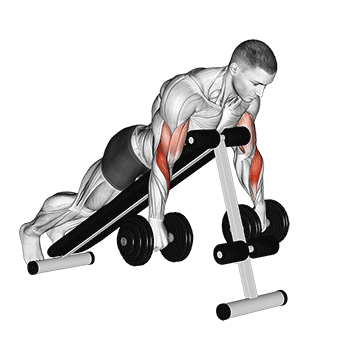
To perform the dumbbell reverse spider curl, start by selecting a pair of dumbbells of appropriate weight.
1. Position yourself on an incline bench, lying face down with your chest securely against the pad. Your feet should be flat on the ground for stability.
2. Hold the dumbbells in each hand with your arms fully extended towards the floor. Your palms should be facing towards you, this is the reverse grip.
3. Without moving your upper arms, bend your elbows to curl the dumbbells as close to your shoulders as you can. Keep your elbows tucked in close to your torso at all times.
4. Pause at the top of the curl for a moment, squeezing your biceps hard.
5. Slowly lower the dumbbells back to the starting position, keeping the tension on your biceps.
6. Repeat for the desired number of repetitions.
Remember to keep your movements controlled, avoid using your back or shoulders to lift the weights. The focus should be on the biceps. Adjust the weight as needed to complete the exercise with proper form.
dumbbell reverse preacher curl
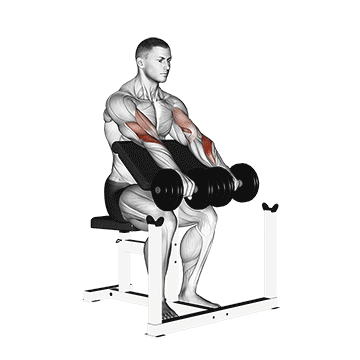
1. Start by selecting a dumbbell of appropriate weight. Remember, it's better to start light and increase weight as you get comfortable with the exercise.
2. Position yourself on a preacher bench, facing the bench. Your chest should be pressed against the top of the bench and your arms should be extended over the other side.
3. Hold the dumbbell with an underhand grip (palms facing upwards) in one hand. Your arm should be fully extended and the back of your upper arm should be resting on the bench.
4. Slowly curl the dumbbell up towards your shoulder, keeping your upper arm stationary. Only your forearm should move during this exercise.
5. Pause for a moment at the top of the curl, squeezing your bicep muscle.
6. Slowly lower the dumbbell back to the starting position. This should take about twice as long as it did to lift it.
7. Repeat for the desired number of repetitions, then switch arms.
8. Remember to keep your movements slow and controlled, focusing on the muscle contraction and not on the weights you are lifting.
9. Avoid using your back or shoulders to lift the weights; your biceps should do all the work.
10. Breathe in as you lower the dumbbell and breathe out as you curl it.
This exercise can be done in sets of 8-12 reps, depending on your strength and endurance.
dumbbell revers grip biceps curl
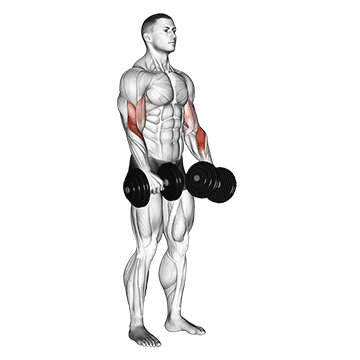
1. Stand up straight with a dumbbell in each hand, arms fully extended, and palms facing your torso. This will be your starting position.
2. While holding the upper arm stationary, curl the weights while contracting the biceps as you breathe out. Only the forearms should move. Continue the movement until your biceps are fully contracted and the dumbbells are at shoulder level. Hold the contracted position for a brief moment as you squeeze the biceps.
3. Slowly begin to bring the dumbbells back to the starting position as your breathe in.
4. Repeat the process for the recommended amount of repetitions.
Remember to keep your elbows close to your torso at all times and do not use your back or shoulders to lift the weights; your biceps should do all the work.
dumbbell prone incline hammer curl
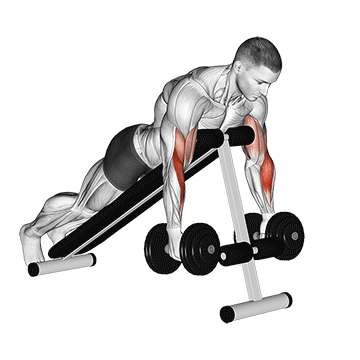
1. Start by selecting a pair of dumbbells of appropriate weight that you can lift without straining your muscles.
2. Position yourself on an incline bench set at about 45 degrees. Lie down on your stomach with your chest firmly against the bench. Your feet should be flat on the ground for stability.
3. Hold the dumbbells in each hand with your palms facing each other. This is the starting position.
4. Slowly curl the dumbbells up towards your shoulders while keeping your elbows close to your body. Ensure that your palms are still facing each other. This is the hammer curl position.
5. Hold this position for a second, squeezing your biceps at the top of the movement.
6. Gradually lower the dumbbells back to the starting position. Ensure that you fully extend your arms and feel a stretch in your biceps.
7. Repeat this movement for the desired number of repetitions.
Remember to keep your body stationary throughout the exercise, moving only your forearms. Also, ensure that you maintain a controlled motion, avoiding any jerky movements.
dumbbell prone incline curl
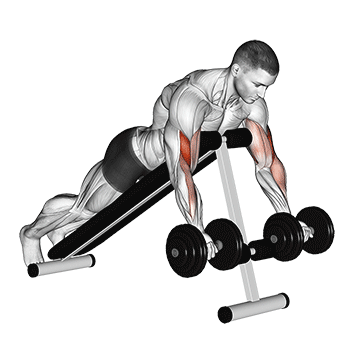
To perform the dumbbell prone incline curl, start by setting an incline bench at a 45-degree angle.
1. Grab a pair of dumbbells and lie face down on the bench, letting your arms hang straight down from your shoulders. Ensure your feet are firmly planted on the ground for stability.
2. Hold the dumbbells with your palms facing forward. This is your starting position.
3. Slowly curl the dumbbells up towards your shoulders while keeping your elbows stationary. Ensure you only move your forearms during this motion.
4. Pause for a moment when the dumbbells are at shoulder level and squeeze your biceps.
5. Slowly lower the dumbbells back to the starting position. This completes one rep.
6. Repeat for the desired number of repetitions.
Remember to keep your body still throughout the exercise, focusing on the bicep contraction and relaxation. Avoid using your back or shoulders to lift the weights; your arms should do all the work.
dumbbell preacher curl over exercise ball
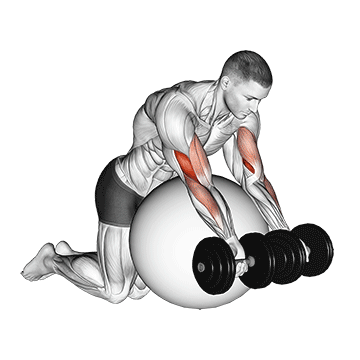
1. Start by selecting a dumbbell of appropriate weight. Remember, it's better to start light and increase weight as needed to maintain proper form.
2. Position an exercise ball in front of you and stand with your feet shoulder-width apart for stability.
3. Lean forward and place the upper part of your arm on the exercise ball. Your arm should be fully extended and perpendicular to the floor. This is your starting position.
4. Hold the dumbbell with an underhand grip (palms facing up) and keep your elbow close to your body.
5. Slowly curl the dumbbell up towards your shoulder while keeping your upper arm stationary. Ensure that only your forearm is moving.
6. Squeeze your biceps at the top of the movement, hold for a second, then slowly lower the dumbbell back to the starting position.
7. Repeat this movement for the desired number of repetitions.
8. Once you've completed your set, switch arms and repeat the exercise.
Remember to keep your back straight and your movements controlled throughout the exercise. Avoid using your back or shoulders to lift the weight; your biceps should do all the work.
dumbbell preacher curl
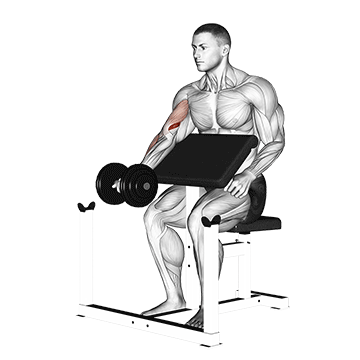
To perform the dumbbell preacher curl, start by selecting a dumbbell of appropriate weight. Ensure you are near a preacher bench for this exercise.
1. Sit on the preacher bench and adjust the height so that your armpits rest comfortably at the top of the pad.
2. Hold the dumbbell with your right hand, using an underhand grip (palm facing upwards).
3. Extend your arm fully, and place the back of your upper arm on the preacher bench. Your arm should be fully extended and your palm should be facing upward.
4. Curl the dumbbell slowly upwards, while keeping your upper arm and elbow stationary on the bench. Continue curling until your biceps are fully contracted and the dumbbell is at shoulder level. Hold the contracted position for a moment as you squeeze your biceps.
5. Slowly begin to bring the dumbbell back to the starting position as your breathe in.
6. Repeat for the recommended amount of repetitions.
7. Switch arms and repeat the exercise.
Remember to keep your movements slow and controlled, focusing on the muscle contraction and not on the weights you are lifting. Avoid using your back or shoulders to lift the weights; your biceps should do all the work.
dumbbell peacher hammer curl
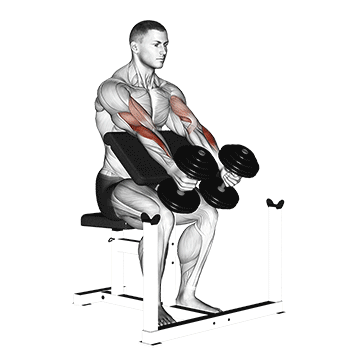
To perform the dumbbell preacher hammer curl, start by selecting the appropriate weight of dumbbells. Ensure you choose a weight that is challenging but allows you to maintain proper form throughout the exercise.
1. Position yourself on a preacher bench, placing your upper arms and chest against the pad. Your feet should be flat on the floor for stability.
2. Hold a dumbbell in each hand with your palms facing your torso. This is your starting position.
3. Keeping your upper arms stationary, exhale and curl the weights while contracting your biceps. Continue to raise the weights until your biceps are fully contracted and the dumbbells are at shoulder level. Hold the contracted position for a brief moment as you squeeze your biceps.
4. Inhale and slowly begin to lower the dumbbells back to the starting position.
5. Repeat for the recommended amount of repetitions.
Remember to keep your elbows close to your torso at all times and do not use your back or shoulders to lift the weights; your biceps should do all the work. Maintain control of the dumbbells at all times; do not let them control you. This exercise can also be performed one arm at a time.
dumbbell over bench one arm neutral wrist curl
1. Start by selecting a dumbbell of appropriate weight. Remember, it's better to start light and increase weight as you get comfortable with the exercise.
2. Sit on the edge of a flat bench with your feet firmly planted on the ground. Hold the dumbbell in one hand with a neutral grip, meaning your palm should be facing inwards towards your body.
3. Lean forward slightly and place your elbow on your thigh, just above the knee. Your arm should be extended and the dumbbell should be hanging down towards the floor.
4. Keep your upper arm stationary, curl the dumbbell upwards by contracting your biceps. Ensure that only your forearm is moving and your wrist remains neutral throughout the movement.
5. Slowly lower the dumbbell back to the starting position. This is one rep.
6. Complete your desired number of reps on one arm, then switch to the other arm and repeat the exercise.
7. Remember to keep your movements slow and controlled, focusing on the muscle contraction and not on the weights you are lifting.
8. Breathe in as you lower the dumbbell and breathe out as you curl it up.
9. Aim for 2-3 sets of 10-15 reps on each arm, or as advised by your trainer.
Remember, the key to this exercise is keeping your wrist neutral and focusing on the bicep muscle contraction.
dumbbell over bench neutral wrist curl
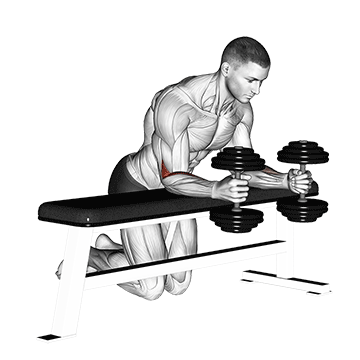
1. Start by selecting a dumbbell of appropriate weight. Remember, it's better to start light and increase weight as needed to maintain proper form.
2. Sit on the edge of a flat bench with your feet firmly planted on the ground. Hold the dumbbell in your right hand with a neutral grip, meaning your palm should be facing inwards towards your body.
3. Lean forward slightly and place your right elbow on your right thigh, just above the knee. Your arm should be fully extended and the dumbbell should be hanging down towards the floor.
4. Keep your upper arm stationary, curl the dumbbell upwards towards your shoulder. Ensure that only your forearm is moving and your wrist remains in a neutral position throughout the movement.
5. Slowly lower the dumbbell back down to the starting position. This is one repetition.
6. Complete your desired number of repetitions and then switch to your left arm.
7. Remember to keep your back straight and your movements controlled throughout the exercise. Avoid using your back or shoulders to lift the weight; your biceps should be doing the work.
8. Repeat this exercise for 2-3 sets of 10-15 repetitions on each arm, or as recommended by your fitness professional.
Remember, the key to this exercise is control and form, not the amount of weight you can lift.
dumbbell one arm zottman preacher curl
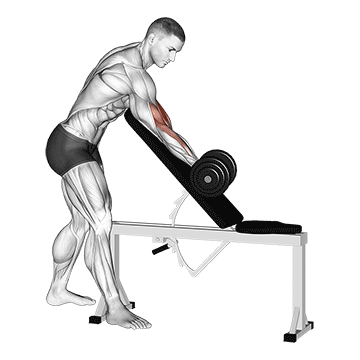
1. Start by selecting a dumbbell of appropriate weight. Remember, it's better to start light and increase weight as you get comfortable with the exercise.
2. Position yourself on a preacher bench, ensuring your chest is pressed against the padding and your feet are flat on the floor.
3. Hold the dumbbell in your right hand with an underhand grip (palms facing up). Your arm should be fully extended and resting on the preacher bench pad.
4. Slowly curl the dumbbell up towards your shoulder while keeping your upper arm and elbow stationary on the pad. This is your starting position.
5. As you reach the top of the movement, rotate your wrist so that your palm is now facing downwards. This is the "Zottman" part of the curl.
6. Lower the dumbbell back down to the starting position while maintaining this overhand grip.
7. Once you reach the bottom, rotate your wrist back to the underhand grip.
8. Repeat the movement for your desired number of repetitions.
9. After completing the set with your right arm, switch the dumbbell to your left hand and repeat the exercise.
10. Remember to keep your movements controlled, focusing on the muscle contraction and not on the weights you are lifting. Avoid using your back or shoulders to lift the weights; your biceps should do all the work.
11. Breathe in as you lower the dumbbell and breathe out as you curl it up.
12. Always ensure your form is correct to avoid injury and maximize the effectiveness of the exercise.
dumbbell one arm standing hammer curl
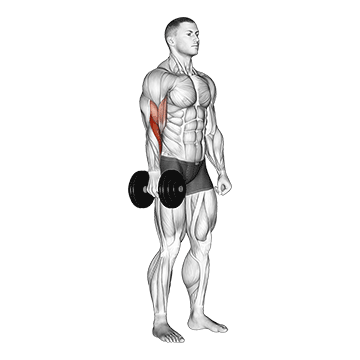
1. Stand up straight with a dumbbell in one hand, your feet shoulder-width apart. This will be your starting position.
2. Keep your elbow close to your torso at all times. The palm of your hand should be facing your torso. This will be your starting position.
3. Now, while holding your upper arm stationary, exhale and curl the weight while contracting your biceps. Continue to raise the weight until your biceps are fully contracted and the dumbbell is at shoulder level. Hold the contracted position for a brief moment as you squeeze your biceps.
4. Then inhale and slowly begin to lower the dumbbell back to the starting position.
5. Repeat the process for the recommended amount of repetitions. Then switch arms and repeat the exercise.
6. Ensure your upper body remains stationary throughout the exercise. The forearms should do all the work. Your upper arms should remain stationary at all times.
dumbbell one arm standing curl
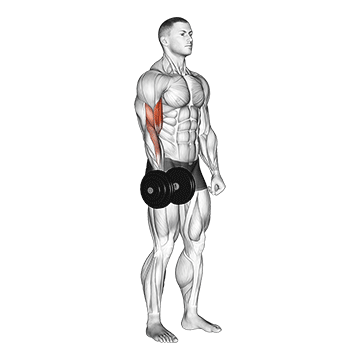
1. Stand up straight with a dumbbell in one hand, keeping your feet shoulder-width apart. This will be your starting position.
2. Keep your elbow close to your torso at all times. The palm of your hand should be facing forward, and the dumbbell should be fully extended.
3. Now, keeping the upper arm stationary, curl the weights while contracting your biceps as you breathe out. Continue to raise the weight until your biceps are fully contracted and the dumbbells are at shoulder level. Hold the contracted position for a brief moment as you squeeze your biceps.
4. Slowly begin to bring the dumbbell back to the starting position as your breathe in.
5. Repeat the process for the recommended amount of repetitions. Then switch arms and repeat the exercise.
Remember to keep your head up and your eyes facing forward. Your upper arm should remain stationary throughout the exercise, only your forearms should move.
dumbbell one arm seated hammer curl
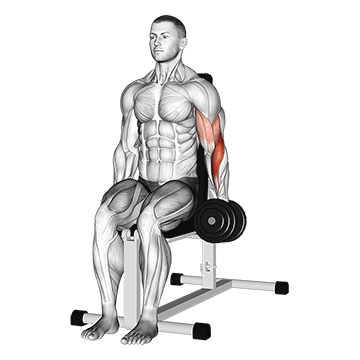
1. Begin by sitting on a flat bench with a dumbbell in one hand. Your feet should be flat on the floor, about shoulder-width apart.
2. Keep your back straight and your core engaged. Your palm should be facing your torso, this is the starting position.
3. Curl the dumbbell while keeping the upper arm stationary, continue to curl the weight until your biceps are fully contracted and the dumbbell is at shoulder level. Hold the contracted position for a brief moment as you squeeze your biceps.
4. Slowly begin to bring the dumbbell back to the starting position as your breathe in.
5. Repeat for the recommended amount of repetitions. Then switch arms and repeat the exercise.
6. Ensure to keep your elbows close to your torso at all times and do not use your back or shoulders to lift the weights; your biceps should do all the work.
Remember, the key to this exercise is the hammer grip, in which your palms face your torso, which engages not only the biceps, but also the brachialis, a muscle of the upper arm.
dumbbell one arm seated bicep curl on exercise ball
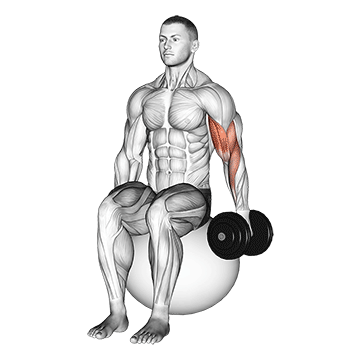
1. Start by sitting upright on an exercise ball with your feet flat on the floor, shoulder-width apart for stability.
2. Hold a dumbbell in one hand with your palm facing forward. The other hand can rest on your hip or the exercise ball for balance.
3. Keep your elbow close to your body and your upper arm stationary throughout the exercise. This is your starting position.
4. Slowly curl the dumbbell up towards your shoulder, contracting your bicep as you do so. Ensure that only your forearm is moving and that you maintain control of the dumbbell at all times.
5. Pause at the top of the curl for a moment, squeezing your bicep for maximum muscle engagement.
6. Slowly lower the dumbbell back to the starting position, maintaining control of the weight as you do so. This completes one rep.
7. Repeat the exercise for your desired number of repetitions before switching to the other arm.
8. Remember to keep your back straight and your core engaged throughout the exercise to protect your spine and enhance the workout's effectiveness.
9. For best results, perform this exercise slowly and with control, focusing on the muscle contraction and not on the weights you are lifting.
dumbbell one arm reverse spider curl
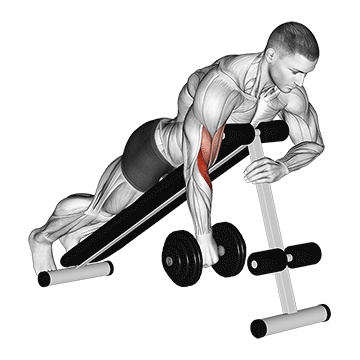
To perform the dumbbell one arm reverse spider curl, follow these steps:
1. Start by selecting a dumbbell of appropriate weight. Remember, it's better to start light and increase the weight as you get comfortable with the movement.
2. Position yourself on a preacher bench, facing forward. The bench should be adjusted so that your armpits rest comfortably at the top of the pad.
3. Hold the dumbbell in one hand with an overhand grip (palms facing down). Your arm should be fully extended and hanging over the side of the bench.
4. Keep your upper arm stationary, exhale and curl the weights while contracting your biceps. Continue to raise the weight until your biceps are fully contracted and the dumbbells are at shoulder level. Hold the contracted position for a brief moment as you squeeze your biceps.
5. Inhale and slowly begin to lower the dumbbell back to the starting position.
6. Repeat for the recommended amount of repetitions. Then switch arms and perform the exercise.
Remember to keep your back straight and your movements controlled throughout the exercise. Avoid using your back or shoulders to lift the weights; your biceps should do all the work.
dumbbell one arm reverse preacher curl
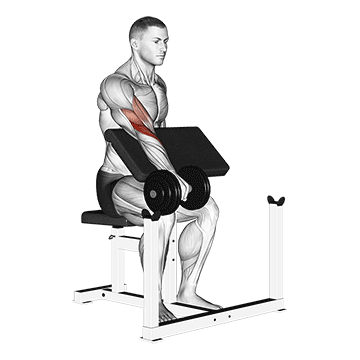
1. Start by selecting a dumbbell of appropriate weight. Remember, it's better to start light and increase weight as you get comfortable with the exercise.
2. Position yourself on a preacher bench, ensuring your arm is resting comfortably on the bench's pad. Your arm should be fully extended and your palm should be facing downwards.
3. Hold the dumbbell in your hand with an overhand grip (your palms facing towards the floor). This is your starting position.
4. Slowly curl the dumbbell upwards, keeping your upper arm stationary and using your forearm to lift the weight. Continue this movement until the dumbbell is at shoulder level.
5. Pause for a moment at the top of the movement, squeezing your biceps for maximum muscle engagement.
6. Gradually lower the dumbbell back to the starting position, maintaining control of the weight throughout the movement. This should take about twice as long as it did to lift the weight.
7. Repeat the exercise for your desired number of repetitions before switching to the other arm.
Remember to keep your back straight and your movements smooth throughout the exercise. Avoid using your back or shoulders to lift the weight; your biceps should be doing the work.
dumbbell one arm prone hammer curl
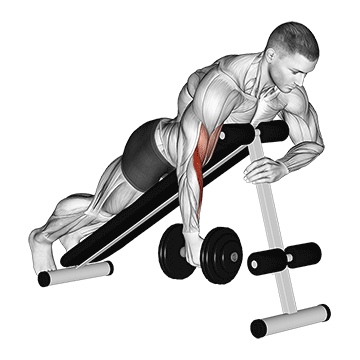
To perform the dumbbell one arm prone hammer curl, follow these steps:
1. Start by selecting a dumbbell of appropriate weight. Remember, it's better to start light and increase weight as you get comfortable with the exercise.
2. Position yourself on an incline bench set at about 45 degrees. Lie face down on the bench with your chest and stomach pressed against the bench.
3. Hold the dumbbell in one hand with a neutral grip, meaning your palm should be facing towards your torso. Let your arm hang straight down from the shoulder.
4. Keep your upper arm stationary, exhale and curl the weight while contracting your biceps. Continue to raise the weight until your biceps are fully contracted and the dumbbell is at shoulder level. Hold the contracted position for a brief moment as you squeeze your biceps.
5. Inhale and slowly begin to lower the dumbbell back to the starting position.
6. Repeat for the recommended amount of repetitions. Then switch arms and perform the exercise.
Remember to keep your body stationary throughout the exercise. The only part of your body that should move is your forearm. This will ensure that your biceps are fully engaged in the exercise.
dumbbell one arm prone curl
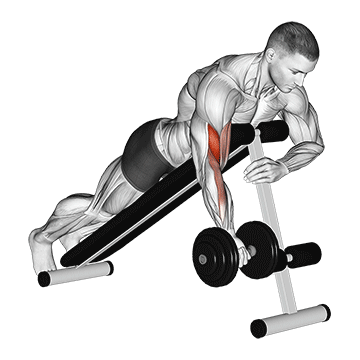
To perform the dumbbell one arm prone curl, follow these steps:
1. Start by selecting a dumbbell of appropriate weight. Remember, it's better to start light and increase the weight as you get comfortable with the exercise.
2. Position yourself on an incline bench, lying face down. Ensure your chest and stomach are firmly pressed against the bench for stability.
3. Hold the dumbbell in one hand with a supinated grip (palm facing upwards). Your arm should be fully extended and perpendicular to the floor. This is your starting position.
4. Slowly curl the dumbbell upwards, keeping your elbow stationary and using only your biceps to lift the weight. Continue the movement until the dumbbell is at shoulder level.
5. Hold this position for a second, squeezing your biceps at the top of the movement.
6. Gradually lower the dumbbell back to the starting position, maintaining control of the weight throughout the descent.
7. Repeat the movement for your desired number of repetitions before switching to the other arm.
Remember to keep your body still throughout the exercise, focusing on isolating the biceps during the curl. Avoid using your back or shoulders to lift the weight, as this can lead to injury.
dumbbell one arm hammer preacher curl
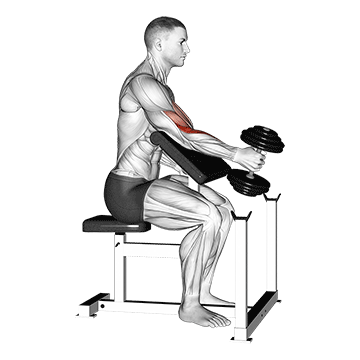
1. Start by selecting a dumbbell of appropriate weight. Remember, it's better to start light and increase weight as you get comfortable with the exercise.
2. Position yourself on a preacher bench, placing your feet firmly on the ground. The sloping part of the bench should be comfortably fitting into your armpit.
3. Hold the dumbbell in your right hand with a neutral grip, meaning your palm should be facing your torso.
4. Extend your arm fully, but don't lock your elbow. This is your starting position.
5. Slowly curl the dumbbell up, keeping your upper arm stationary. The only part of your arm that should move is your forearm.
6. Continue to curl the weight until the dumbbell is at shoulder level and your bicep is fully contracted. Ensure that your palm is still facing your torso.
7. Hold this position for a second to maximize the peak contraction in the bicep.
8. Gradually lower the dumbbell back to the starting position, maintaining control of the movement throughout.
9. Repeat the movement for your desired number of repetitions.
10. Once you've completed your set, switch the dumbbell to your left hand and repeat the exercise.
Remember to keep your back straight and avoid using your shoulders or back to lift the weight. The focus should be on isolating the bicep muscle.
dumbbell one arm concetration curl (on stability ball)
_Upper-Arms_360.gif)
1. Start by selecting a dumbbell of appropriate weight. Remember, it's better to start light and increase weight as you get comfortable with the exercise.
2. Sit on a stability ball with your feet flat on the floor, shoulder-width apart. Make sure your back is straight and your core is engaged.
3. Hold the dumbbell in your right hand. Place your right elbow on the inside of your right thigh, just above the knee. Your arm should be fully extended and the dumbbell should be hanging down towards the floor.
4. Slowly curl the dumbbell up towards your shoulder, keeping your upper arm stationary. Only your forearm should move. Make sure to keep your wrist straight and avoid any swinging motion.
5. Pause at the top of the curl, squeezing your bicep muscle for a moment before slowly lowering the dumbbell back to the starting position.
6. Repeat this movement for your desired number of repetitions. Once you've completed a set with your right arm, switch the dumbbell to your left hand and repeat the exercise.
7. Remember to keep your back straight and your core engaged throughout the exercise. This will help maintain balance on the stability ball and ensure the focus remains on your biceps.
8. For best results, aim for 3 sets of 8-12 repetitions on each arm. As you get stronger, you can increase the weight of the dumbbell or the number of sets or repetitions.
dumbbell lying wide curl
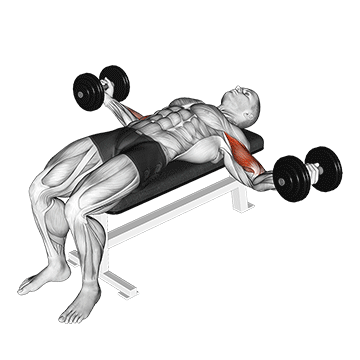
1. Start by selecting a pair of dumbbells of appropriate weight that you can lift comfortably.
2. Lie flat on your back on a bench, with your feet firmly planted on the ground for stability.
3. Hold the dumbbells in each hand with your palms facing up. Extend your arms out to your sides, forming a T shape with your body. This is your starting position.
4. Slowly bend your elbows and curl the dumbbells towards your shoulders. Keep your elbows stationary and only move your forearms.
5. Pause for a moment when the dumbbells are at shoulder level, squeezing your biceps at the top of the movement.
6. Slowly lower the dumbbells back to the starting position, fully extending your arms and stretching your biceps.
7. Repeat this movement for your desired number of repetitions.
Remember to keep your movements controlled and steady, focusing on the muscle contraction and not on the weights you are lifting. Avoid using your back or shoulders to lift the weights; your biceps should do all the work.
dumbbell lying supine curl
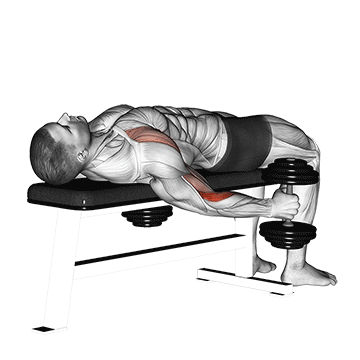
1. Start by selecting a pair of dumbbells of appropriate weight. Remember, it's better to start light and increase weight as you get comfortable with the exercise.
2. Lie down on a flat bench with your feet firmly planted on the ground. Hold the dumbbells in your hands with your palms facing up (supine position).
3. Extend your arms fully so that they are perpendicular to the floor. This is your starting position.
4. Slowly bend your elbows and curl the dumbbells towards your shoulders. Keep your upper arms stationary and use your biceps to lift the weights. Ensure your elbows are close to your torso at all times.
5. Pause for a moment when the dumbbells are at shoulder level and your biceps are fully contracted. Squeeze your biceps at the top of the movement for maximum muscle engagement.
6. Slowly lower the dumbbells back to the starting position, maintaining control of the weights as you do so. This should take about twice as long as it did to lift them.
7. Repeat for the desired number of repetitions.
Remember to breathe in as you lower the weights and breathe out as you curl them. Keep your movements smooth and controlled, avoiding any jerky motions or using your back or shoulders to lift the weights.
dumbbell lying supine biceps curl
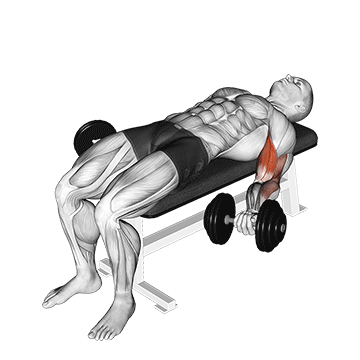
1. Start by selecting a pair of dumbbells of appropriate weight. Remember, it's better to start light and increase weight as needed to maintain proper form.
2. Lie down on a flat bench with your feet firmly planted on the ground. Hold the dumbbells with an underhand grip (palms facing upwards) and extend your arms fully.
3. Keep your elbows close to your torso at all times. This is your starting position.
4. Slowly curl the weights while contracting your biceps as you breathe out. Keep the upper arms stationary, use your forearms to lift the weights. Continue the movement until your biceps are fully contracted and the dumbbells are at shoulder level. Hold the contracted position for a brief moment as you squeeze your biceps.
5. Gradually begin to bring the dumbbells back to the starting position as your breathe in.
6. Repeat for the recommended amount of repetitions.
Remember to keep your movements slow and controlled, don't use your back or shoulders to lift the weights; your biceps should do all the work.
dumbbell lunge with bicep curl
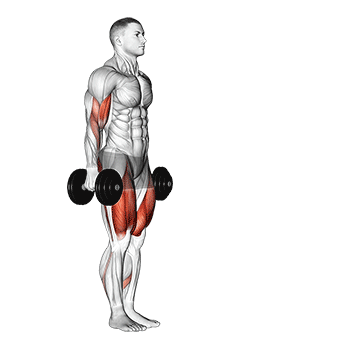
To perform the dumbbell lunge with bicep curl, follow these steps:
1. Stand upright with your feet hip-width apart. Hold a dumbbell in each hand with your arms fully extended and palms facing forward.
2. Take a step forward with your right foot, lowering your body into a lunge position. Your right knee should be bent at a 90-degree angle and your left knee should be hovering just above the ground.
3. As you lower into the lunge, curl the dumbbells up towards your shoulders, keeping your elbows close to your body. This is the bicep curl part of the exercise.
4. Push off your right foot to return to the starting position, lowering the dumbbells back down to your sides.
5. Repeat the lunge and bicep curl with your left foot stepping forward.
6. Continue to alternate legs for the desired number of reps.
Remember to keep your back straight and your core engaged throughout the exercise. Also, ensure that your knee does not go over your toes when you are in the lunge position to avoid injury.
dumbbell kneeling bicep curl exercise ball
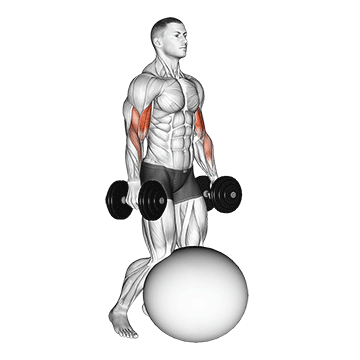
To perform the dumbbell kneeling bicep curl exercise ball, follow these steps:
1. Start by selecting a pair of dumbbells of appropriate weight that you can lift without straining your muscles.
2. Position an exercise ball in front of you and kneel down on it. Make sure your body is balanced and stable before proceeding to the next step.
3. Hold the dumbbells in each hand with your palms facing forward. Your arms should be fully extended and hanging down by your sides. This is your starting position.
4. Slowly curl the weights while keeping your upper arms stationary, exhale as you do this. Continue to raise the weights until your biceps are fully contracted and the dumbbells are at shoulder level. Hold the contracted position for a brief moment as you squeeze your biceps.
5. Gradually begin to lower the dumbbells back to the starting position in a controlled manner while inhaling.
6. Repeat this movement for the desired number of repetitions.
Remember to keep your elbows close to your torso at all times and do not use your back or shoulders to lift the weights; your biceps should do all the work. Ensure your movements are slow and controlled; it's not about the weight you lift, but the technique you use.
dumbbell incline inner biceps curl
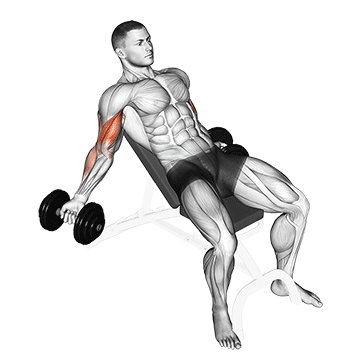
1. Start by selecting a pair of dumbbells of appropriate weight. Remember, it's better to start light and increase weight as you get comfortable with the movement.
2. Sit down on an incline bench set at about 45 degrees. Hold a dumbbell in each hand at arm's length, palms facing each other. This is your starting position.
3. Keep your elbows close to your torso at all times. Now, while keeping the upper arms stationary, curl the weights while contracting your biceps as you breathe out. Only the forearms should move. Continue the movement until your biceps are fully contracted and the dumbbells are at shoulder level. Hold the contracted position for a brief moment as you squeeze your biceps.
4. Inhale and slowly begin to lower the dumbbells back to the starting position.
5. Repeat for the recommended amount of repetitions.
6. Ensure to keep your upper body still throughout the exercise. The arms should be doing all the work. Also, do not use your back or shoulders to lift the weights; your biceps should do all the work.
7. It's important to maintain good form over heavy weights. If you can't do the exercise with good form, reduce the weight of the dumbbells.
8. This exercise can be performed alternatively with one arm at a time or with both arms simultaneously.
dumbbell incline hammer curl
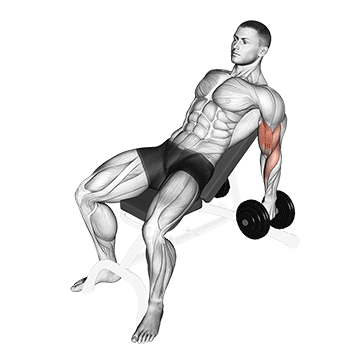
1. Start by setting an incline bench at a 45-degree angle.
2. Sit on the bench with a dumbbell in each hand, palms facing your torso. This will be your starting position.
3. Keep your upper arms stationary, exhale and curl the weights while contracting your biceps. Continue to raise the weights until your biceps are fully contracted and the dumbbells are at shoulder level. Hold the contracted position for a brief moment as you squeeze your biceps.
4. Inhale and slowly begin to lower the dumbbells back to the starting position.
5. Repeat this movement for the recommended amount of repetitions.
Remember to keep your elbows close to your torso at all times and do not use your back or shoulders to lift the weights; your biceps should do all the work. Also, ensure your movements are slow and controlled - don't let the dumbbells' weight pull your arms down rapidly.
dumbbell incline curl v. 2
To perform the dumbbell incline curl v. 2, start by setting an incline bench at a 45-degree angle.
1. Sit down on the bench with a dumbbell in each hand, palms facing forward. Your feet should be flat on the floor for stability.
2. Allow your arms to hang down fully extended, perpendicular to the floor. This is your starting position.
3. Keeping your upper arms stationary, curl the weights while contracting your biceps as you breathe out. Only your forearms should move. Continue the movement until your biceps are fully contracted and the dumbbells are at shoulder level. Hold the contracted position for a brief moment as you squeeze your biceps.
4. Slowly begin to bring the dumbbells back to the starting position as your breathe in.
5. Repeat for the recommended amount of repetitions.
Remember to keep your elbows close to your torso at all times and do not use your back or shoulders to lift the weights; your biceps should do all the work. Ensure your movements are slow and controlled, avoiding any swinging or jerking motion.
dumbbell incline curl
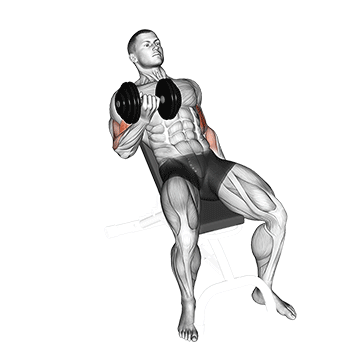
1. Start by setting an incline bench at a 45-degree angle.
2. Sit down on the bench with a dumbbell in each hand, palms facing forward. Your feet should be flat on the floor and your back pressed firmly against the bench.
3. Allow your arms to hang down fully extended, perpendicular to the floor. This is your starting position.
4. Keeping your upper arms stationary, exhale and curl the weights while contracting your biceps. Continue to raise the weights until your biceps are fully contracted and the dumbbells are at shoulder level. Hold the contracted position for a brief moment as you squeeze your biceps.
5. Inhale and slowly begin to lower the dumbbells back to the starting position.
6. Repeat for the recommended amount of repetitions.
Remember to keep your elbows close to your torso at all times and do not use your back or shoulders to lift the weights; your biceps should do all the work. Also, ensure your movements are slow and controlled, avoiding any jerky motions or swinging of the dumbbells.
dumbbell incline biceps curl
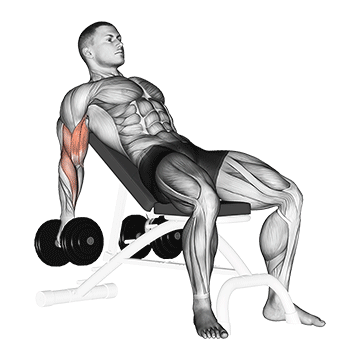
1. Start by selecting a pair of dumbbells of appropriate weight that you can lift without straining your muscles.
2. Sit down on an incline bench adjusted to a 45-degree angle. Hold a dumbbell in each hand at arm's length, with your palms facing forward. This is your starting position.
3. Keep your upper arms stationary, exhale and curl the weights while contracting your biceps. Continue to raise the weights until your biceps are fully contracted and the dumbbells are at shoulder level. Hold the contracted position for a brief moment as you squeeze your biceps.
4. Inhale and slowly begin to lower the dumbbells back to the starting position.
5. Repeat the movement for the prescribed amount of repetitions.
6. Ensure your elbows are close to your torso at all times and do not use your back or shoulders to lift the weights; your biceps should do all the work.
7. Remember to keep your head steady and look straight ahead to maintain balance and prevent injury.
8. It's important to perform this exercise with a controlled motion, avoiding any sudden movements or dropping the weights quickly.
9. Repeat this exercise for the desired number of sets.
This exercise is great for isolating the biceps and can be incorporated into any arm strengthening routine.
dumbbell high curl
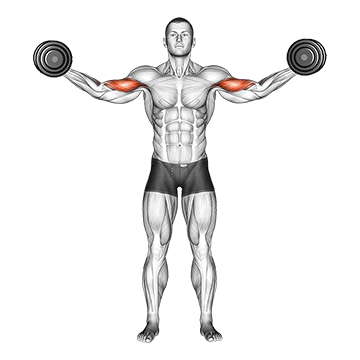
To perform the dumbbell high curl, start by standing up straight with a dumbbell in each hand, arms fully extended, and palms facing your torso. This will be your starting position.
Next, while keeping your upper arms stationary, exhale and curl the weights while contracting your biceps. Continue to raise the weights until your biceps are fully contracted and the dumbbells are at shoulder level. Hold the contracted position for a brief moment as you squeeze your biceps.
Then, inhale and slowly begin to lower the dumbbells back to the starting position.
Remember to keep your elbows close to your torso at all times. The upper arms should remain stationary throughout the exercise; only the forearms should move.
Repeat this movement for the recommended amount of repetitions.
Ensure you maintain good posture throughout the exercise, with your back straight and your core engaged. Avoid using your back or shoulders to lift the weights; your biceps should do all the work.
dumbbell hammer curls (with arm blaster)
_Forearms_360.gif)
1. Start by selecting a pair of dumbbells of appropriate weight. Remember, it's better to start light and increase weight gradually to avoid injury.
2. Stand up straight with a dumbbell in each hand, arms fully extended, and palms facing your torso. This will be your starting position.
3. Put on your arm blaster. This is a belt-like device that goes around your neck and has a metal plate that sits against your abdomen. It helps to isolate the biceps during the exercise.
4. Keep your elbows close to your torso at all times. Your upper arms should remain stationary as you perform the exercise.
5. Now, while holding your upper arm stationary, exhale and curl the weights while contracting your biceps. Continue to raise the weights until your biceps are fully contracted and the dumbbells are at shoulder level. Hold the contracted position for a brief moment as you squeeze your biceps.
6. Inhale and slowly begin to lower the dumbbells back to the starting position.
7. Repeat this movement for the recommended amount of repetitions.
Remember to keep your elbows close to your torso at all times and the upper arms stationary. This puts all the emphasis on the biceps. The key to this exercise is the hammer grip, in which your palms are facing your torso, which engages not only the biceps, but also the forearms.
dumbbell hammer curl v. 2
To perform the Dumbbell Hammer Curl V. 2, follow these steps:
1. Stand up straight with a dumbbell in each hand, arms fully extended, and palms facing your torso. This will be your starting position.
2. Keep your upper arms stationary, exhale and curl the weights while contracting your biceps. Continue to raise the weights until your biceps are fully contracted and the dumbbells are at shoulder level. Hold the contracted position for a brief moment as you squeeze your biceps.
3. Now, only the forearms should move. Your upper arms should remain stationary at all times.
4. Then inhale and slowly begin to lower the dumbbells back to the starting position.
5. Repeat this motion for the desired number of repetitions.
Remember to keep your elbows close to your torso at all times. Do not use your back or shoulders to lift the weights; your biceps should do all the work.
dumbbell hammer curl on exercise ball
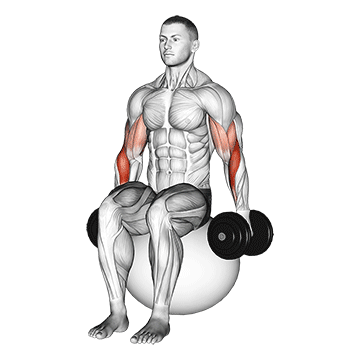
1. Start by selecting a pair of dumbbells of appropriate weight that you can lift without straining your muscles.
2. Sit on an exercise ball with your feet flat on the floor, shoulder-width apart for stability.
3. Hold the dumbbells with your palms facing your torso, arms fully extended, and elbows close to your torso. This is your starting position.
4. Keep your upper arms stationary, exhale and curl the weights while contracting your biceps. Continue to raise the weights until your biceps are fully contracted and the dumbbells are at shoulder level. Hold the contracted position for a brief pause as you squeeze your biceps.
5. Inhale and slowly begin to lower the dumbbells back to the starting position.
6. Repeat this movement for the desired number of repetitions.
Remember to keep your elbows close to your torso at all times and do not use your back or shoulders to lift the weights; your biceps should do all the work. Also, maintain control and do not allow the dumbbells to drop quickly, lower them in a slow, controlled manner.
dumbbell hammer curl
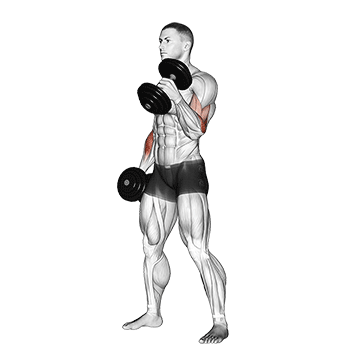
To perform the dumbbell hammer curl, start by standing up straight with a dumbbell in each hand, arms fully extended, and palms facing your torso. This will be your starting position.
Keep your elbows close to your torso at all times. Now, while holding your upper arm stationary, exhale and curl the weight while contracting your biceps. Continue to raise the weight until your biceps are fully contracted and the dumbbells are at shoulder level. Hold the contracted position for a brief moment as you squeeze your biceps.
Inhale and slowly begin to lower the dumbbells back to the starting position. Remember to keep your palms facing your torso throughout the movement.
Repeat this movement for the recommended amount of repetitions. Ensure to keep your elbows close to your body during the entire movement to maximize bicep muscle engagement.
dumbbell cross body hammer curl v. 2
To perform the Dumbbell Cross Body Hammer Curl V. 2, follow these steps:
1. Stand up straight with a dumbbell in each hand, arms fully extended, and palms facing your torso. This will be your starting position.
2. While keeping your palms facing your torso, curl the right weight across your body towards your left shoulder as you exhale. Keep the rest of your body still as you lift the weight. Your forearm should do all the work.
3. Continue to lift the weight until your biceps are fully contracted and the dumbbells are at shoulder level. Hold the contracted position for a brief moment as you squeeze your biceps.
4. Inhale and slowly begin to lower the dumbbell back to the starting position.
5. Repeat the movement with the left hand. This completes one rep.
6. Continue alternating in this manner for the recommended amount of repetitions.
Remember to keep your elbows close to your torso at all times and do not use your back or shoulders to lift the weights; your biceps should do all the work.
dumbbell cross body hammer curl
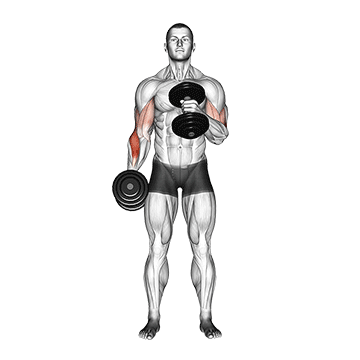
1. Stand up straight with a dumbbell in each hand, arms fully extended, and palms facing your torso. This will be your starting position.
2. While keeping your palms facing your torso, curl the right dumbbell towards your left shoulder as you breathe out. Try to keep the rest of the body still as you do this movement.
3. Continue the movement until your biceps are fully contracted and the dumbbells are at shoulder level. Hold the contracted position for a second as you squeeze the biceps.
4. Slowly begin to bring the dumbbells back to the starting position as your breathe in.
5. Repeat the movement but this time curl the left dumbbell towards your right shoulder. Continue alternating in this manner until all of the recommended repetitions for each arm have been completed.
Remember to keep your elbows close to your torso at all times and do not use your back or shoulders to lift the weights; your biceps should do all the work.
dumbbell concentration curl
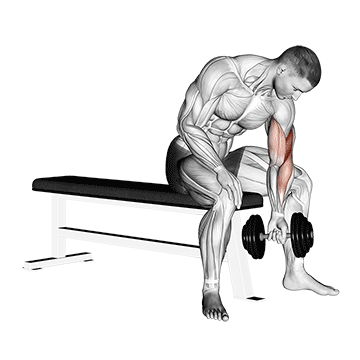
1. Start by selecting a dumbbell of appropriate weight. Remember, it's better to start light and increase weight as you get comfortable with the exercise.
2. Sit on the edge of a flat bench with your legs spread apart. Your feet should be firmly planted on the ground.
3. Pick up the dumbbell with your right hand. Rest your right elbow on the inside of your right thigh, just above the knee. Your arm should be fully extended and the dumbbell should be just off the floor.
4. Keep your back straight and your core engaged throughout the exercise. This is your starting position.
5. Slowly curl the dumbbell up towards your chest, keeping your upper arm stationary. Only your forearm should move. Make sure to breathe out as you perform this movement.
6. Hold the contraction at the top for a second and squeeze your biceps.
7. Gradually lower the dumbbell back to the starting position, inhaling as you do so.
8. Repeat for the recommended amount of repetitions.
9. Once you've completed your set, switch arms and repeat the exercise.
Remember to keep your movements slow and controlled, focusing on the muscle contraction and not on the weights you're lifting. This will ensure you're targeting your biceps effectively.
dumbbell biceps curl v sit on bosu ball
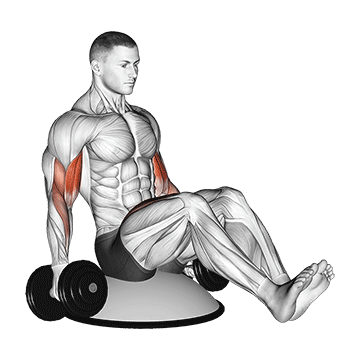
1. Start by placing a Bosu ball on the floor with the flat side down.
2. Carefully sit on the center of the rounded side of the Bosu ball. Your knees should be bent and your feet flat on the floor for balance.
3. Hold a dumbbell in each hand with your arms fully extended and palms facing forward. This is your starting position.
4. Slowly curl the weights while keeping your upper arms stationary. Continue to raise the weights until your biceps are fully contracted and the dumbbells are at shoulder level. Hold the contracted position for a brief pause as you squeeze your biceps.
5. Gradually lower the dumbbells back to the starting position in a controlled manner.
6. Repeat the movement for the desired number of repetitions.
Remember to keep your abdominal muscles engaged and maintain a straight back throughout the exercise. This will help you maintain balance on the Bosu ball and also work your core.
Also, ensure that you use a weight that is challenging but allows you to perform the exercise with correct form. If the weight is too heavy, you risk straining your muscles or losing balance on the Bosu ball.
dumbbell biceps curl squat
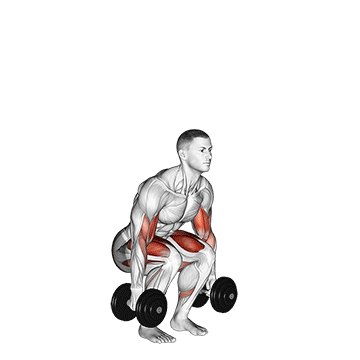
1. Start by standing tall with your feet shoulder-width apart. Hold a dumbbell in each hand with your arms fully extended, and palms facing forward. This is your starting position.
2. Bend your knees and hips to lower your body into a squat position. Keep your chest up and your back straight. Your thighs should be parallel to the floor.
3. As you hold the squat position, curl the dumbbells towards your shoulders while keeping your elbows close to your body. Ensure your upper arms are stationary and only the forearms move.
4. Hold the curl position for a second, squeezing your biceps at the top.
5. Slowly lower the dumbbells back to the starting position while maintaining the squat.
6. Push through your heels to stand back up to the starting position.
7. Repeat the exercise for the desired number of repetitions.
Remember to keep your core engaged throughout the exercise and avoid using your back or shoulders to lift the weights. The focus should be on the biceps.
dumbbell biceps curl reverse
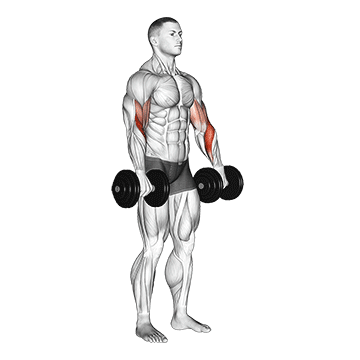
1. Stand up straight with a dumbbell in each hand, arms fully extended, and palms facing your torso. This will be your starting position.
2. While holding the upper arm stationary, curl the weights while contracting the biceps as you breathe out. Only the forearms should move. Continue the movement until your biceps are fully contracted and the dumbbells are at shoulder level. Hold the contracted position for a brief moment as you squeeze the biceps.
3. Slowly begin to bring the dumbbells back to the starting position as your breathe in.
4. Repeat this movement for the recommended amount of repetitions.
Remember to keep your elbows close to your torso at all times and do not use your back or shoulders to lift the weights; your biceps should do all the work.
dumbbell biceps curl (with arm blaster)
_Upper-arms_360.gif)
1. Start by selecting a pair of dumbbells of appropriate weight. Remember, the weight should be challenging but manageable to maintain proper form.
2. Stand up straight with a dumbbell in each hand, arms fully extended, and palms facing forward. Your feet should be shoulder-width apart.
3. Put on the arm blaster belt. This should be positioned around your neck and adjusted so that the metal part is at your abdominal level. This will help isolate your biceps during the exercise.
4. Keep your elbows close to your torso at all times. This is your starting position.
5. Now, keeping the upper arms stationary, exhale and curl the weights while contracting your biceps. Continue to raise the weights until your biceps are fully contracted and the dumbbells are at shoulder level. Ensure that only your forearms are moving. Your upper arms should remain stationary next to your torso.
6. Hold the contracted position for a brief pause as you squeeze your biceps.
7. Inhale and slowly begin to lower the dumbbells back to the starting position.
8. Repeat this movement for the desired number of repetitions.
Remember to keep your body stationary throughout the exercise. The arm blaster will help prevent your elbows from moving, ensuring that your biceps are doing all the work.
dumbbell biceps curl
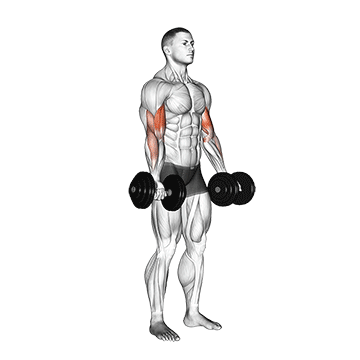
To perform the dumbbell biceps curl, start by standing up straight with a dumbbell in each hand, arms fully extended, and palms facing forward. Your feet should be shoulder-width apart. This is your starting position.
Next, keep your upper arms stationary, exhale and curl the weights while contracting your biceps. Continue to raise the weights until your biceps are fully contracted and the dumbbells are at shoulder level. Hold the contracted position for a brief pause as you squeeze your biceps.
Then, inhale and slowly begin to lower the dumbbells back to the starting position.
Remember to keep your elbows close to your torso at all times. Do not use your back or shoulders to lift the weights; your hands should be the only part moving.
Repeat this process for the recommended amount of repetitions.
Ensure you maintain good form throughout the exercise. If you find your form is slipping, consider using lighter weights.
dumbbell bicep curl with stork stance
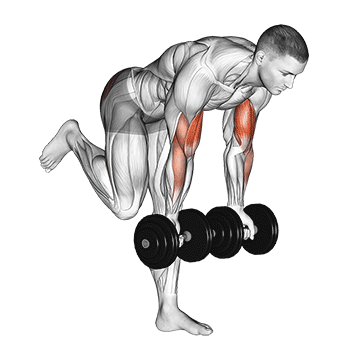
To perform the dumbbell bicep curl with stork stance, follow these steps:
1. Stand upright and hold a dumbbell in each hand at arm's length. Your elbows should be close to your torso and your palms should be facing your torso. This is your starting position.
2. Lift your right foot off the ground, balancing on your left foot. This is the stork stance.
3. Keep your upper arms stationary, exhale and curl the weights while contracting your biceps. Continue to raise the weights until your biceps are fully contracted and the dumbbells are at shoulder level. Hold the contracted position for a brief pause as you squeeze your biceps.
4. Inhale and slowly begin to lower the dumbbells back to the starting position.
5. Repeat the movement for the prescribed amount of repetitions.
6. Switch to balancing on your right foot and repeat the exercise for the same amount of repetitions.
Remember to keep your elbows close to your torso at all times and do not use your back or shoulders to lift the weights; your biceps should do all the work. Maintain balance and control throughout the exercise.
dumbbell bicep curl on exercise ball with leg raised
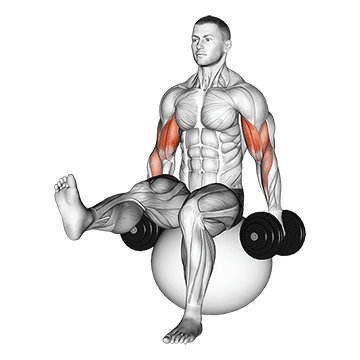
1. Start by selecting a pair of dumbbells of appropriate weight that you can lift without straining your muscles.
2. Position yourself on an exercise ball. Make sure your feet are flat on the floor and your back is straight.
3. Hold the dumbbells in your hands with your palms facing forward. Your arms should be fully extended and your elbows close to your torso. This is your starting position.
4. Slowly raise one leg off the floor, keeping it straight. This will engage your core and improve your balance.
5. Curl the weights while contracting your biceps as you breathe out. Keep the upper arms stationary, use your forearms to lift the weights. Continue the movement until your biceps are fully contracted and the dumbbells are at shoulder level. Hold the contracted position for a brief pause as you squeeze your biceps.
6. Slowly begin to bring the dumbbells back to the starting position as your breathe in.
7. Repeat the movement for the recommended amount of repetitions. Then switch and raise the other leg off the floor and repeat the exercise.
8. Remember to keep your back straight and your movements smooth throughout the exercise.
9. For beginners, start with lighter weights and gradually increase as your strength improves.
10. Always ensure to maintain proper form to avoid injury and maximize the effectiveness of the exercise.
dumbbell bicep curl lunge with bowling motion
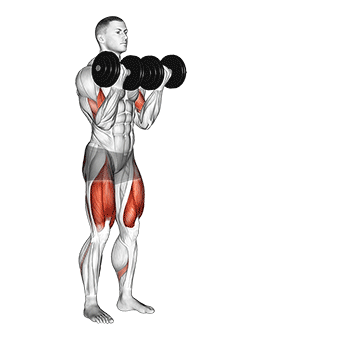
1. Start by standing straight with your feet shoulder-width apart. Hold a dumbbell in each hand with your palms facing forward. This is your starting position.
2. Step forward with your right foot into a lunge position. Your right knee should be directly above your right ankle, and your left knee should be bent and hovering just above the floor.
3. As you step into the lunge, simultaneously curl the dumbbells up towards your shoulders, keeping your elbows close to your body. This is the bicep curl part of the exercise.
4. Lower the dumbbells back down to your sides as you push back up to the starting position.
5. Now, repeat the lunge and bicep curl with your left foot stepping forward.
6. After completing the bicep curl with both legs, perform the bowling motion. To do this, hold the dumbbell in your right hand and swing it back like you're about to bowl. Then, swing it forward as if you're releasing a bowling ball. Make sure to keep your arm straight and your wrist firm throughout the motion.
7. Repeat the bowling motion with your left hand.
8. This completes one repetition. Aim to do 3 sets of 10-15 repetitions, alternating between the bicep curl lunges and the bowling motion.
Remember to keep your back straight and your core engaged throughout the exercise. Also, ensure that the weight you're using for the dumbbells is challenging but manageable. If you're struggling to maintain form, consider using a lighter weight.
dumbbell alternating seated bicep curl on exercise ball
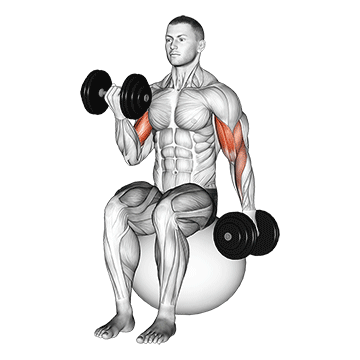
Begin by sitting upright on an exercise ball with your feet flat on the floor, shoulder-width apart. Hold a dumbbell in each hand with your arms fully extended and palms facing forward.
Slowly curl one dumbbell up towards your shoulder while keeping your elbow stationary. As you lift the weight, contract your bicep and exhale. Ensure that only your forearm is moving.
Hold the contracted position for a moment as you squeeze your bicep. Then, slowly lower the dumbbell back to the starting position while inhaling.
Repeat the same movement with the other arm. This completes one repetition.
Continue alternating arms for the desired number of repetitions. Remember to keep your back straight and your core engaged throughout the exercise to maintain balance on the exercise ball.
dumbbell alternating bicep curl with leg raised on exercise ball
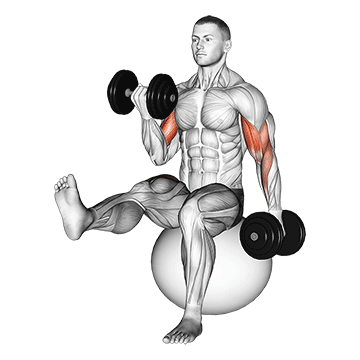
1. Start by selecting a pair of dumbbells of appropriate weight that you can comfortably lift.
2. Position an exercise ball behind you. Stand tall with your feet shoulder-width apart, holding a dumbbell in each hand with your arms fully extended, and palms facing forward.
3. Lift your right foot and place it on top of the exercise ball behind you. This will be your starting position.
4. Keep your upper arms stationary, exhale and curl the dumbbell in your left hand while contracting your bicep. Continue to raise the dumbbell until your bicep is fully contracted and the dumbbell is at shoulder level. Hold the contracted position for a brief moment as you squeeze your bicep.
5. Inhale and slowly begin to lower the dumbbell back to the starting position.
6. As you are lowering the left dumbbell, begin to curl the right one. Repeat the movement on the right side.
7. Continue to alternate between both arms while keeping your right foot on the exercise ball for balance and stability.
8. After completing the desired number of reps, switch and raise your left foot on the exercise ball and repeat the exercise.
9. Remember to keep your elbows close to your torso at all times and do not use your back or shoulders to lift the weights; your biceps should do all the work.
10. Repeat this exercise for the recommended amount of repetitions or until fatigue sets in.
This exercise not only targets your biceps but also helps improve balance and core stability.
dumbbell alternate seated hammer curl
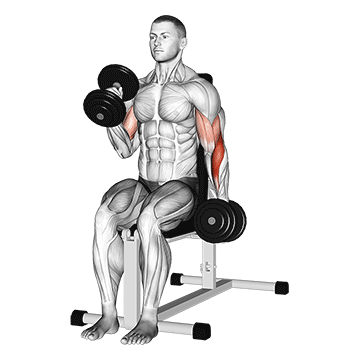
1. Start by sitting down on a flat bench with a dumbbell in each hand at arm's length. Keep your elbows close to your torso at all times. This will be your starting position.
2. Now, while holding your upper arm stationary, exhale and curl the weight while contracting your biceps. Continue to raise the weight until your biceps are fully contracted and the dumbbell is at shoulder level. Hold the contracted position for a brief moment as you squeeze your biceps.
3. As you inhale, slowly begin to lower the dumbbell back to the starting position.
4. Repeat the movement with the opposite arm. This completes one rep.
5. Continue alternating arms for the desired number of repetitions.
Remember to keep your palms facing your torso at all times. This is the key characteristic of the hammer curl which targets the brachialis, a muscle of the upper arm.
dumbbell alternate preacher curl
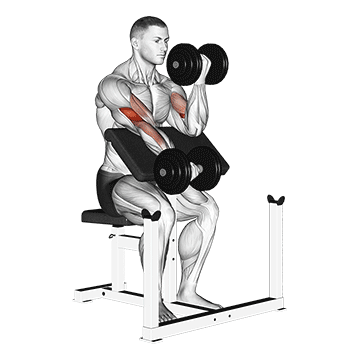
1. Start by selecting a pair of dumbbells of appropriate weight that you can lift comfortably.
2. Position yourself on a preacher bench and adjust the height so that your armpits rest comfortably at the top of the pad.
3. Hold a dumbbell in each hand with your palms facing upwards. This will be your starting position.
4. Slowly lower one dumbbell until your arm is fully extended, and your bicep is fully stretched. Keep your other arm stationary at the top.
5. Curl the dumbbell while contracting your bicep as you breathe out. Continue the movement until your biceps are fully contracted and the dumbbells are at shoulder level. Hold the contracted position for a second as you squeeze your biceps.
6. Slowly begin to bring the dumbbell back to the starting position as your breathe in.
7. Repeat the movement with the other arm. This completes one rep.
8. Continue alternating arms for the desired amount of repetitions.
Remember to keep your upper body stationary throughout the exercise. Only the forearms should move. Your upper arms should remain stationary and on the pad all the time.
dumbbell alternate hammer preacher curl
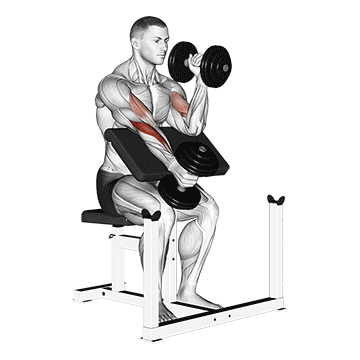
1. Start by selecting a pair of dumbbells of appropriate weight that you can lift comfortably.
2. Sit on the preacher bench and adjust the height so that your armpits rest comfortably at the top of the pad.
3. Hold the dumbbells in each hand with a neutral grip, meaning your palms should be facing each other.
4. Extend your arms fully, placing them against the preacher bench pad. This is your starting position.
5. Slowly curl one dumbbell upwards towards your shoulder while keeping the other dumbbell stationary.
6. As you lift, keep your upper arm and elbow stationary, using only your forearms to lift the weight. Ensure your wrist remains in line with your forearm and doesn't bend.
7. Squeeze your bicep at the top of the movement, hold for a second, then slowly lower the dumbbell back to the starting position.
8. Repeat the same movement with the other arm. This completes one rep.
9. Aim to complete 3 sets of 8-12 reps on each arm, depending on your strength and endurance.
10. Remember to maintain a controlled movement throughout the exercise, avoiding any jerky motions or using your back or shoulders to lift the weight.
11. Always ensure to breathe in as you lower the dumbbell and breathe out as you curl it upwards.
This exercise is great for isolating and building the biceps, and the alternating nature of the exercise helps to engage each arm individually, promoting balanced strength and muscle development.
dumbbell alternate biceps curl (with arm blaster)
_Upper-arms_360.gif)
#ERROR!
dumbbell alternate biceps curl
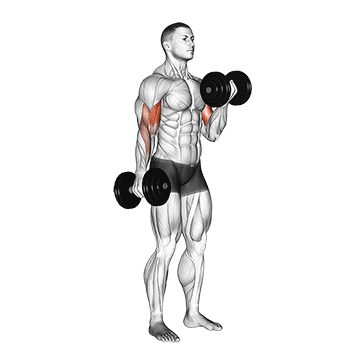
To perform the dumbbell alternate biceps curl, start by standing up straight with a dumbbell in each hand, arms fully extended, and palms facing your torso. This will be your starting position.
Now, while holding your upper arm stationary, exhale and curl the weight while contracting your biceps. Continue to raise the weight until your biceps are fully contracted and the dumbbell is at shoulder level. Hold the contracted position for a brief moment as you squeeze your biceps.
Then, inhale and slowly begin to lower the dumbbell back to the starting position. As you switch arms, make sure to rotate the palms of your hands until they are facing forward. Repeat the movement with the other arm. This is one repetition.
Remember to keep your elbows close to your torso at all times. Do not use your back or shoulders to lift the weights; your biceps should do all the work. Continue the movement until you have completed your set.
For beginners, start with light weights and gradually increase as your strength improves. Aim for 2-3 sets of 8-12 reps each.
No tags for this post.
